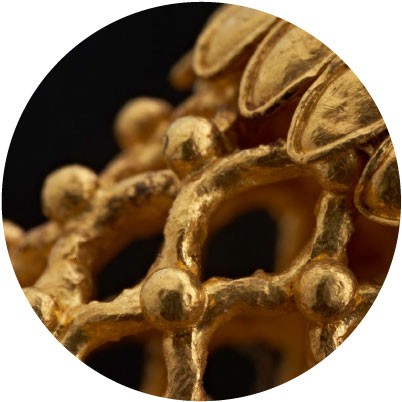The largest collection of gold wreaths and other precious finds from the cemeteries of Macedonia.
During antiquity, Macedonia was famous for its metal sources, whose abundance was the reason for the creation of artistic masterpieces since a very early period as well as for its financial strength. River gold was widely used, such as from the river Echedorus (modern-day Gallikos), along with ores on mountains such as Pangaion or Dysoron.
In historic times, metallurgy flourished twice. Once in the late archaic and early classical times (late 6th and first half of 5th c. BC) and later on during the late classical and early hellenistic times (early 4th to early 2nd c. BC). The artistic and technological quality of the artefacts is remarkable, employing techniques such as filigree and granulation in their manufacture.

The permanent exhibition "The Gold of Macedon" is dedicated tο the ancient Macedonian finds of precious metals. On display are burial assemblages that included artefacts made of metals, which accompanied the dead to the afterlife. Among them are weaponry, symposium vessels made of silver or bronze and top-quality jewellery. The exceptional wreaths form the largest collection of its kind in the world.
The famous Derveni krater is also exhibited here, from ancient Lete, depicting the sacred wedding of Dionysus and Ariadne along with an entourage of satyrs and maenads, as well as the Derveni Papyrus, which in 2015 became the first Greek register on the UNESCO Memory of the World list.





























